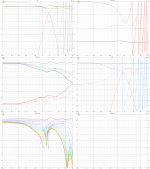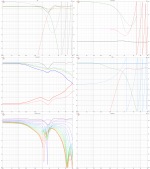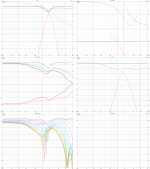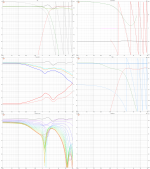In this days of digital age time alignement is a no issue.
For passive xover it's different but still there is ways to approach it.
For passive xover it's different but still there is ways to approach it.
@krivium: I´ve meant only the coax, not the whole box.
@jjasniew: I think this design is more than SSC-technology. AFAIK is this suspension build from some sort of fabric, which act like a baffle for the tweeter and, at the same time, as a filter for the mid-driver. A few pros and no cons, so to speak, and the measurements shows that it works.
But I never heard the Krons (or the Caldera III, for that matter), so I don´t really know how it sounds.
@jjasniew: I think this design is more than SSC-technology. AFAIK is this suspension build from some sort of fabric, which act like a baffle for the tweeter and, at the same time, as a filter for the mid-driver. A few pros and no cons, so to speak, and the measurements shows that it works.
But I never heard the Krons (or the Caldera III, for that matter), so I don´t really know how it sounds.
https://hificompass.com/en/speakers/measurements/sbacoustics/sb-acoustics-sb26stcn-c000-4So the so fer discussion supported me in my plan to give an MTM a chance, I have 3" fullranges already selected but I would greatly appreciate tweeter tips. After studying what is available in more detail i will lower the bar slightly, so anything > 86dB (1W/m) and 4Ohm is OK.
2xPeerless 3" 830986 (or 830987 which is quite similar - have not seen them earlier and already ordered 830986) and Vifa OX20SC02-04Which ones?
dave
The arguments about less efficient Sd for the same mechanical layout in MTM vs coax are a hard fact.
On the other hand, although I have not looked at practical mechnical details of coax designs but my intuition tells me that the hard mechanical integration of a large midwoofer with a small tweeter in the centre has to have negative impact on the overall design optimization potential. So my hypo(thesis) is even though Sd efficiency is against MTM but the better overall speaker manufacturer freedom can more than offset this disadvantage. Plus apparently the much higher manufacturing cost and thus the cost for comparable speaker designs (MTM vs coax). That would be in line with the limited choice of coax-es on the market and generally their highish prices. Although their quite unpretty looking FR is probably also a siginifcant discouragement (for the market not for me as I have quite solid data to think it matters really little in terms of audible quality)
On the other hand, although I have not looked at practical mechnical details of coax designs but my intuition tells me that the hard mechanical integration of a large midwoofer with a small tweeter in the centre has to have negative impact on the overall design optimization potential. So my hypo(thesis) is even though Sd efficiency is against MTM but the better overall speaker manufacturer freedom can more than offset this disadvantage. Plus apparently the much higher manufacturing cost and thus the cost for comparable speaker designs (MTM vs coax). That would be in line with the limited choice of coax-es on the market and generally their highish prices. Although their quite unpretty looking FR is probably also a siginifcant discouragement (for the market not for me as I have quite solid data to think it matters really little in terms of audible quality)
Peerless 3” 830986...Vifa OX20SC02-04
Minimum spacing gets you quarter wavelength of 775 Hz for it to be able to act as a true point source.
dave
That would mean that coax-es at some freq ranges are not true point sources either. Stil it seems the setup I am thinking about will be close to as good as it gets
Yes, a coax usually needs some time delay to reduce the distance to within that quarterwave criteria. And given that few are likely to be happy with first order, teh DSP XO that creates the time delay would need to be able to do higher order pahse perfect XO.
dave
dave
Only if we are talking about typical pro-sound coax with compression driver firing through the midrange pole piece.That would mean that coax-es at some freq ranges are not true point sources either. Stil it seems the setup I am thinking about will be close to as good as it gets
For home/studio coaxials acoustic center separation is appr. 20 mm or less. This equals 50 deg phase rotation at 2500 Hz, or 1/7 wavelength. We can move the crossover even lower thanks to some degree of horn loading from the midrange cone.
Attachments
Last edited:
Is that the acoustically measured centre or the mechanically measured one?acoustic center separation is appr. 20 mm or less
It is likely different for every driver, that is physically smaller than i would have suspected, but that does not take into account further delay in the woofer from the big VC.
dave
not to mention filter delays all of which are rendered moot if you use a DSP crossover and dial in the needed delay
DSP can do time alignment but only in coax setups (or as close as it gets). That's one of the key reasons why I am so much after the possibly point-source designs
are you sure? I've done it for time alignment in a synergy and in a conventional 2-way and it worked quite well.
I mean the time alignment is not fully stable as the distance to the ears can slight;ly vary depending on the actual listening position. But most of the effect is probably still there, I just have a tendency not to take prisoners 🙂
Seems folks have trouble distinguishing plots from the point of view of the driver from human experience at the receiving end (AKA "the worm's eye view"). Of all the complexity of sound reaching your ears, off-set of tweeters can't matter much.
Most reports I've seen on adjusting timing of drivers to be coincident in time (such as remote subs and main speakers) says there's nothing much to be gained.
B.
Most reports I've seen on adjusting timing of drivers to be coincident in time (such as remote subs and main speakers) says there's nothing much to be gained.
B.
Last edited:
Could you please share a link to a report you think most convincingly proves this point ? It is quite interesting for me as I would rather say the timing aspects are severely underestimated as a condition for high sound fidelity.
Doesn't the group delay show the timing?It is quite interesting for me as I would rather say the timing aspects are severely underestimated as a condition for high sound fidelity.
Have you ever used vcad and adjusted the timing between two ideal drivers?says there's nothing much to be gained.
edit:
I answered my own question... I used vcad on an ideal sim and changed the delay. I have the tweeter very far from a woofer. The sim says with a 0 delay I am getting an on-axis cancellation.
Attachments
Last edited:
Yeah there is about 1/4 wavelength leeway around crossover not to have issues in design axis frequency response. I mean if the phase is past about +/-90 degrees between the drivers towards direction one is inspecting at it shows as dip in frequency response, simple as that. If the drivers are not coincident there is going to be dip anyway to some directions the drivers are stacked. One needs to take account path length difference from each driver to ear, if tweeter is at ear level and woofer below, then the distance to woofer is longer and this makes the difference in phase. Or just lift up the speaker to equalize distance from both drivers to ear. With coincident drivers there is not much issues with this except if the tweeter is crossed over too high, eg. the woofer is too big and response starts to narrow below crossover.
Example in numbers: 2kHz is ~17cm long so path length from drivers to ear can vary +/-4cm or +/-0.125ms and still have pretty much flat response towards the ear. Basically its frequency response to other directions, or lobing, one sees on polar maps that is the result of phase varying to an angle at crossover. This in turn affects response at listening position due to first reflections having different frequency response than direct sound.
Then there is the effect of group delay but the studies have demonstrated it needs to be quite much to start be audible, meaning that if there is single low order crossover at 2kHz on a speaker system then the group delay shouldn't matter much for perceived qualities in which case any perceived difference would come from the frequency response. Either design axis or off-axis through first reflections, basically watch out for the power response / directivity index.
To me this simply means that one should make the speaker so that DI is smooth. In addition try make sound towards first reflection points as much the same as direct sound as possible. Now the timings shouldn't matter mucho, they were fixed just by watching frequency response plots. Its pretty easy to notice anomalies in frequency response, linear distortion. There is case when high order crossovers and multiple ways on the speaker (or any stupid mistakes for example) add excess group delay so much that it starts to be audible but again this shouldn't be much of a problem if one is doing passive crossovers because the slopes are probably quite low order. With modern DSP it is possible to wipe out the excess group delay at will (FIR) but its also possible to make bad excess group delay, just be aware of what that is on the system. Hence first priority is to build the thing so that with crossover the system makes very smooth DI and nice smooth frequency response to important directions, then just checkout there is no stupid things going on with the filters so that excess group delay is reasonable and one should be golden. If not, its time to plan the system, the physical construct again so that such sound is possible!
Example in numbers: 2kHz is ~17cm long so path length from drivers to ear can vary +/-4cm or +/-0.125ms and still have pretty much flat response towards the ear. Basically its frequency response to other directions, or lobing, one sees on polar maps that is the result of phase varying to an angle at crossover. This in turn affects response at listening position due to first reflections having different frequency response than direct sound.
Then there is the effect of group delay but the studies have demonstrated it needs to be quite much to start be audible, meaning that if there is single low order crossover at 2kHz on a speaker system then the group delay shouldn't matter much for perceived qualities in which case any perceived difference would come from the frequency response. Either design axis or off-axis through first reflections, basically watch out for the power response / directivity index.
To me this simply means that one should make the speaker so that DI is smooth. In addition try make sound towards first reflection points as much the same as direct sound as possible. Now the timings shouldn't matter mucho, they were fixed just by watching frequency response plots. Its pretty easy to notice anomalies in frequency response, linear distortion. There is case when high order crossovers and multiple ways on the speaker (or any stupid mistakes for example) add excess group delay so much that it starts to be audible but again this shouldn't be much of a problem if one is doing passive crossovers because the slopes are probably quite low order. With modern DSP it is possible to wipe out the excess group delay at will (FIR) but its also possible to make bad excess group delay, just be aware of what that is on the system. Hence first priority is to build the thing so that with crossover the system makes very smooth DI and nice smooth frequency response to important directions, then just checkout there is no stupid things going on with the filters so that excess group delay is reasonable and one should be golden. If not, its time to plan the system, the physical construct again so that such sound is possible!
Last edited:
Not a 100% expert on group delay but it seems to me to focus on "static" timing, i.e long-term phase differences. That' s not very influential which a few studies have shown. I meant rather transient alignment, so e.g. a step response. The problem with it and its lack of any popularity and credit is that there is no reference nor units of quality measurements.Doesn't the group delay show the timing?
So most of the industry and enthusiasts deliberate at length over hardly perceptible frequency response irregularities like e.g. the ASR portal combat no-prisoners approach to largely secondary tier factors for audio fidelity, IMAHO (Always Humble 🙂
- Home
- Loudspeakers
- Multi-Way
- MTM vs coax for point-source design
![20160915110044_Figure3-RDStoriesGenelec8351[1].jpg](/community/data/attachments/972/972501-1eba34a381d58f9396f35d01b68576f7.jpg?hash=Hro0o4HVj5)



